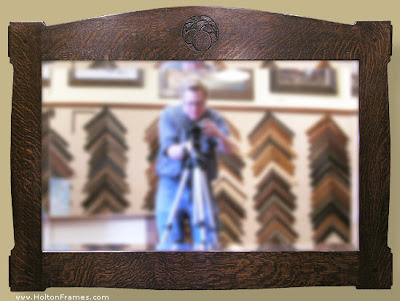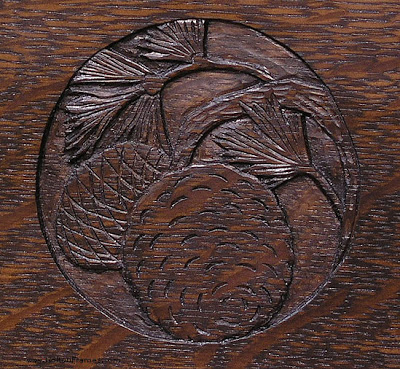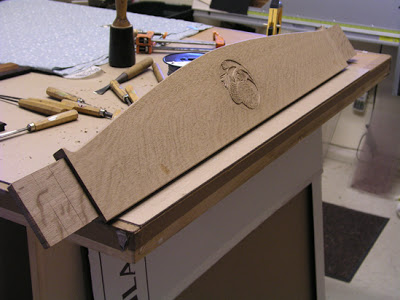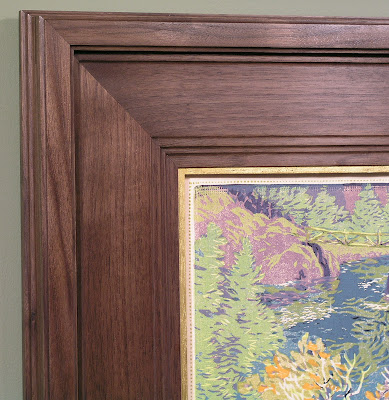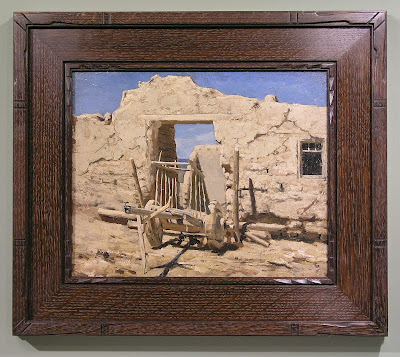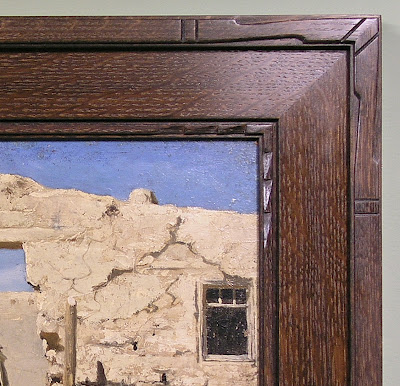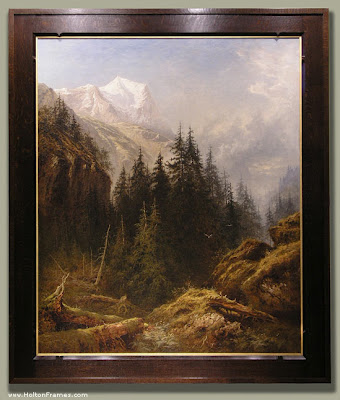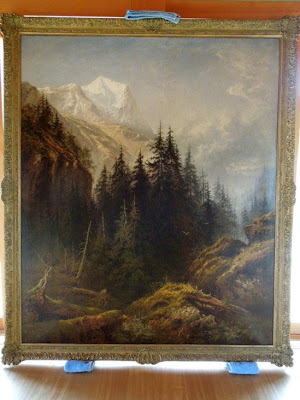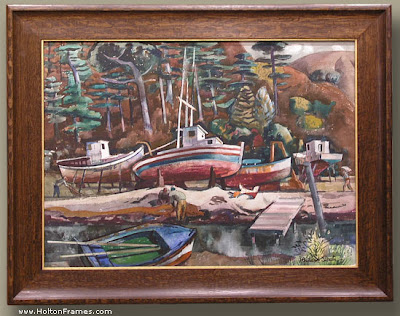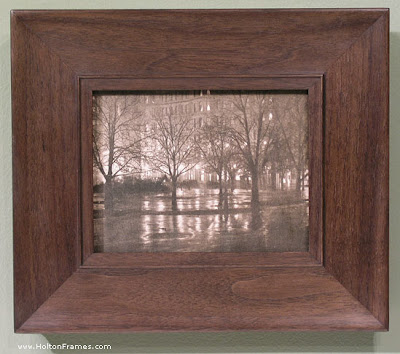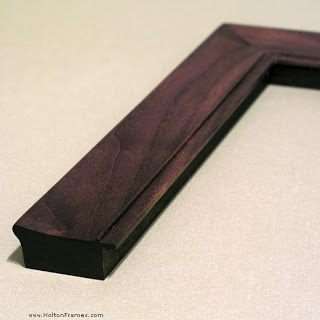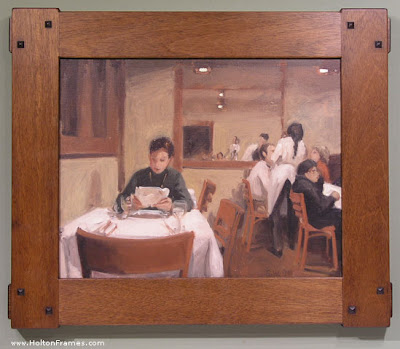I’m at the shop today in Emeryville, but the three of us at Holton Studio are also hanging in the American Museum of Natural History and taking part in the reopening of the North American Mammal Hall for which we produced dozens of hand carved oak frames as well as other fixtures. Read all about it in the New York Times, listen on NPR., and watch on MSNBC (where, at 1:26, you can see one of our frames directly behind the reporter). What a privilege to take part in such a monument of our nation’s public cultural heritage!
Author Archives: admin340
Mirror with Carved Medallion
Here’s a recently commissioned mirror. The design is based on that of a pair of frames I made years ago for two leather panels by CR Ashbee. This mirror is a horizontal adaption of that design, featuring at the top center a carved medallion with two pine cones. The outside dimensions of the frame are 36″ x 48″. The medallion is 4-1/2″ in diameter. Quartersawn white oak with Medieval Oak stain.
Framing Gustave Baumann Prints
Over the years we’ve had the pleasure to frame quite a few prints by master American printmaker Gustave Baumann (1881-1971). Here are three just finished:
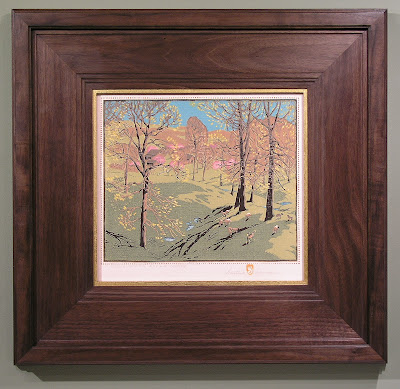 |
| Gustave Baumann, “Early Spring, Brown County” |
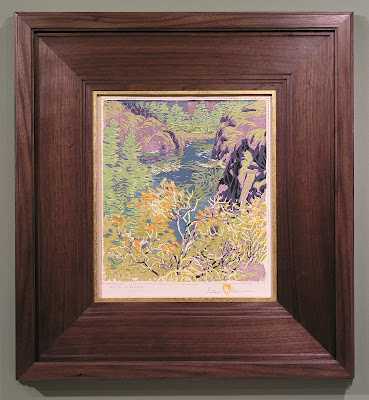 |
| Gustave Baumann, “Rio Pecos” |
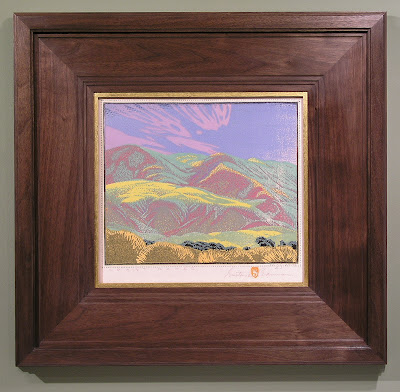 |
| Gustave Baumann, “Coast Range” |
The frames are stained walnut compounds.
The flats are thin to act more as mats, although they’re on top of the glass, and cover the wide margins of the prints. The profiles are wide (4-1/2″ + 3/16″ gilt slips) but simple using 1/8″ radius coves to create a simple rhythm of lines. Here’s a corner detail:
The customer was very kind to let me use this image below of his hallway where he displays earlier Baumanns we’ve framed for him.
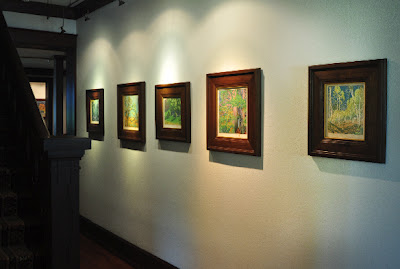 |
| (Ted Ellison photo) |
More Baumanns we’ve framed can be found in the “Prints and Works on Paper” section of the Portfolio.
Framing Thaddeus Welch—Carved Corners
Had the privilege of framing a Thaddeus Welch (1844-1919) oil painting a while back (here). Took a very different approach with this one, playing up the wonderful tradition of Taos frames. Trevor Davis had made a corner sample similar to this, and when the painting came in, the design, with a couple of adjustments (scaled down, made as a flat rather than a slope), would be just right. This is a 3-1/4″ wide compound flat profile with carved corners, in quartersawn white oak with Medieval Oak stain. The painting’s about 12″ x 14-3/4″.
Here’s a detail of the corner:
Framing a Benjamin Williams Leader Landscape
Just finished framing this spectacular 1875 Alpine landscape oil painting by British artist Benjamin Williams Leader (1831 – 1923), titled “The Wetterhorn from Rosenlaui.” At 72″ x 60″ it has a powerful presence (see last photo for scale). Commissioned by a Member of Parliament, John Derby Allcroft, the year it was painted it was displayed at the Royal Academy, where Leader’s work was shown in every summer exhibition from 1854 through 1922.
We made a 6″ wide stained quartersawn white oak compound frame with a chamfered mortise-and-tenon flat and gilt oak liner. The chamfer has carved points that articulate the corners with a detail that also picks up a form pervasive in the painting.
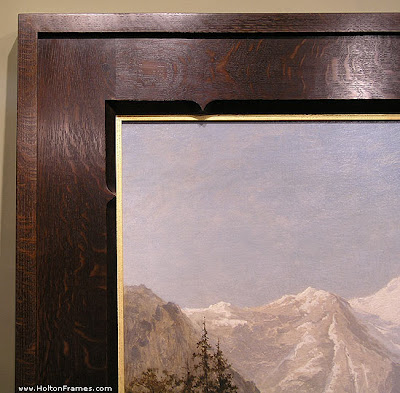 |
| Corner detail |
Below is the painting in its old Victorian makeshift frame—a conventional 19th century exhibition frame heavy on compo (molded plaster-like material meant to pass itself off as carving).
Clearly influenced by John Ruskin’s pleas to painters to go to nature, to see her both truly and reverently—and sharing with Ruskin a passion for the Swiss Alps—Leader contributed in his way to the great project of re-framing art, led by Ruskin and the Pre-Raphaelites. I wonder if, while breaking with convention on the canvas itself, he followed the Pre-Raphaelites, Whistler and others to make his ideals real in the form of the picture frame itself. If so, I hope our efforts would have met with his approval.
This is the third Leader we’ve had the privilege of framing. Another is on my site, here.
View this Leader in the Portfolio…
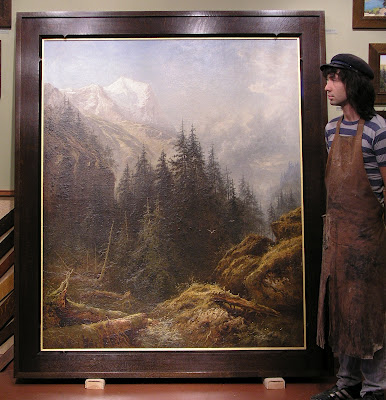 |
| The painting with Eric Johnson next to it to give a sense of scale (Eric’s over 6′ tall). |
Framing a Millard Sheets Watercolor
Another wonderful California watercolor, this one by Millard Sheets: “Boats of Noyo,” 1974, 22″ x 30″. The bold and colorful watercolor has all the presence of an oil painting, warranting our framing it close (an 8-ply gasket mat and lined rabbet, along with Museum Glass, keep it archival). The spirit of the painting demanded a simple profile. The quartersawn oak frame is a 3-1/4″ wide flattened cove to echo the forms of the boats and soft trees and hills. Flattened form suits both the shallow perspective and artist’s approach which is less illusionistic than it is a decorative treatment of the paper as a flat surface. Gilt oak liner.
The view of a thriving craft, and in a beautiful natural setting, sure speaks to me!
Framing Alfred Stieglitz
Am quite pleased with how this one turned out — a little (5″ x 6-1/4″) print of an iconic New York streetscape by one the great masters of photography, Alfred Stieglitz (1864-1946). The frame’s 2″ wide, in walnut with a bit of Nut Brown stain. (For more on framing photographs close, i.e., without a visible mat, read my article “Close Framed Photographs,” for Picture Framing Magazine).
Here’s a better look at the profile:
Paul Kratter Wins Plein Air Awards
Paul Kratter is sporting two more feathers in his cap. At last month’s Carmel Art Festival, his painting “Rush Hour” (oil on canvas, 8″ x 16″) was awarded Second Place—a feat topped this month with first prize honors for his “Glory Days” (oil on canvas, 10″ x 20″) at the Laguna Plein Air Painters Association Best of Plein Air Show! No doubt about it, Paul’s clearly established himself as one of California’s top landscape painters.
Congratulations, Paul!
| Rush Hour |
| Glory Days |
Framing Stan Washburn and Chez Panisse
Pictures that depict frames and finish trim always offer the frame-maker an opportunity to achieve a high degree of harmony and unity between the picture and the frame.
Such is the case with this Stan Washburn oil on canvas — a view of the Craftsman interior of Berkeley’s famous restaurant, Chez Panisse. For the 14″ x 18″ picture we used a 3″ Four-Square Basic (done without the usual reveals on profiles of this frame this size) in Honduran Mahogany with a light stain to harmonize. Mahogany square plugs (they appear darker because you see the end grain, which absorbs more stain). The Craftsman-style interior is carried out by the iconic Craftsman mortise-and-tenon joinery in the frame. The otherwise plain profile works not only with the architectural details depicted, but with the loose painting style. If the picture were more tightly rendered and/or had more detailed and finer line work, then a more formal frame, or at least a more formal liner in this frame, would be called for.
